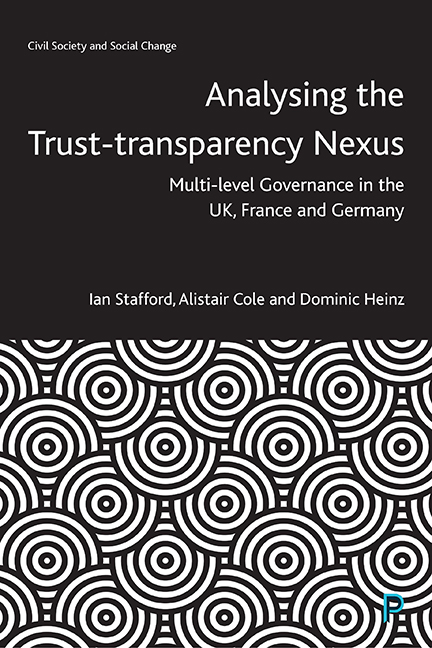Book contents
- Frontmatter
- Dedication
- Contents
- List of figures and tables
- List of abbreviations
- About the authors
- Acknowledgements
- Introduction
- 1 Building trust in an age of transparency
- 2 The trust–transparency nexus
- 3 Comparing cases
- 4 UK: North West England and Wales
- 5 Germany: Hesse and Saxony-Anhalt
- 6 France: Auvergne-Rhône-Alpes and Bretagne
- Conclusion: reflections on the trust–transparency nexus
- Appendix: qualitative fieldwork guide
- References
- Index
1 - Building trust in an age of transparency
Published online by Cambridge University Press: 15 September 2022
- Frontmatter
- Dedication
- Contents
- List of figures and tables
- List of abbreviations
- About the authors
- Acknowledgements
- Introduction
- 1 Building trust in an age of transparency
- 2 The trust–transparency nexus
- 3 Comparing cases
- 4 UK: North West England and Wales
- 5 Germany: Hesse and Saxony-Anhalt
- 6 France: Auvergne-Rhône-Alpes and Bretagne
- Conclusion: reflections on the trust–transparency nexus
- Appendix: qualitative fieldwork guide
- References
- Index
Summary
Trust is perhaps one of the most contested and nebulous concepts within contemporary academic research. Grimmelikhuijsen and colleagues (2013: 577) note that ‘across and even within disciplines, a myriad of definitions, concepts, and operationalizations are being used in research’ and therefore providing clarity in terms of what we mean and understand when discussing trust is itself challenging. Levi (1998: 79, quoted in Newton 2007: 343), for example, noted that trust ‘is not one thing and it does not have one source; it has a variety of forms and causes’. Any academic journal article, monograph or edited volume which directly or indirectly engages with questions of trust is relatively incomplete without a section or chapter devoted to what we mean by trust. Rousseau and colleagues (1998: 394), for example, tackled this challenge head-on in their attempt to develop a multidisciplinary view of trust which provides ‘clear boundaries to usefully inform research and theory’. They settle on a definition where trust is characterised as ‘a psychological state comprising the intention to accept vulnerability based upon positive expectations of the intentions or behaviour of another’ (Rousseau et al, 1998: 395). While this parsimonious definition provides a useful starting point for a cross-disciplinary discussion of trust, it does not go very far in terms of understanding the dynamics of building trust and of different dimensions of trust which characterise contemporary governance, such as interpersonal, institutional and interorganisational dynamics (Nooteboom, 1996; Edelenbos and Klijn, 2007; Klijn et al, 2010; Edelenbos and Eshuis, 2012; Fuglsang and Jagd, 2015).
This chapter explores approaches to contemporary debates on the concept of trust. It takes as a starting point that trust can be understood as a complex, multidimensional concept and that context is potentially key (Zmerli and Hooghe, 2011; Grimmelikhuijsen et al, 2013; Meijer, 2013). The chapter is divided into four sections. The first examines contemporary approaches to defining and conceptualising trust. The second explores core assumptions about how trust can be utilised within the context of our multi-level cases. The third section explores how we can understand the dynamics between interpersonal and interorganisational trust. And the fourth engages in a discussion of trust and closely related concepts.
- Type
- Chapter
- Information
- Analysing the Trust-Transparency NexusMulti-level Governance in the UK, France and Germany, pp. 11 - 24Publisher: Bristol University PressPrint publication year: 2022



